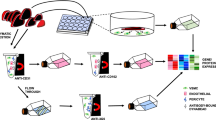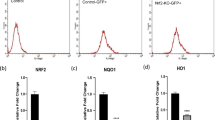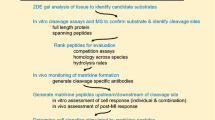Abstract
Endocardial endothelium, which lines the chambers of the heart, is distinct in its origin, structure, and function. Characterization studies using genomics and proteomics have reported molecular signatures supporting the structural and functional heterogeneity of various endothelial cells. However, though functionally very important, no studies at protein level have been conducted so far characterizing endocardial endothelium. In this study, we used endothelial cells from pig heart to investigate if endocardial endothelial cells are distinct at the proteome level. Using a high-throughput liquid chromatography-tandem mass spectrometry for proteome profiling and expression, we identified sets of proteins that belong to specific biological processes and metabolic pathways in endocardial endothelial cells supporting its specific structural and functional roles. The study also identified several transcription factors and cell surface markers, which may have roles in the specificity of endocardial endothelium. The detection of sets proteins preferentially expressed in endocardial endothelium offers new insights into its role in the regulation of cardiac function. Data are made available through ProteomeXchange with identifier PXD009194.



Similar content being viewed by others
References
Yano K, Gale D, Massberg S et al (2007) Phenotypic heterogeneity is an evolutionarily conserved feature of the endothelium. Blood 109:613–615. https://doi.org/10.1182/blood-2006-05-026401
Ishii Y, Langberg J, Rosborough K, Mikawa T (2008) Endothelial cell lineages of the heart. Cell Tissue Res 335:67–73. https://doi.org/10.1007/s00441-008-0663-z
Misfeldt AM, Boyle SC, Tompkins KL et al (2009) Endocardial cells are a distinct endothelial lineage derived from Flk1+ multipotent cardiovascular progenitors. Dev Biol 333:78–89. https://doi.org/10.1016/j.ydbio.2009.06.033
Brutsaert DL, Meulemans a L, Sipido KR, Sys SU (1988) Effects of damaging the endocardial surface on the mechanical performance of isolated cardiac muscle. Circ Res 62:358–366. https://doi.org/10.1161/01.RES.62.2.358
Bruneel A, Labas V, Mailloux A et al (2003) Proteomic study of human umbilical vein endothelial cells in culture. Proteomics 3:714–723. https://doi.org/10.1002/pmic.200300409
Liu Z, Xu B, Nameta M et al (2013) Profiling of kidney vascular endothelial cell plasma membrane proteins by liquid chromatography-tandem mass spectrometry. Clin Exp Nephrol 17:327–337. https://doi.org/10.1007/s10157-012-0708-1
Zieger MA, Gupta MP, Wang M (2011) Proteomic analysis of endothelial cold-adaptation. BMC Genom 12:630. https://doi.org/10.1186/1471-2164-12-630
Smith JA, Radomski MW, Schulz R et al (1993) Porcine ventricular endocardial cells in culture express the inducible form of nitric oxide synthase. Br J Pharmacol 108:1107–1110. https://doi.org/10.1111/j.1476-5381.1993.tb13512.x
Ando H, Kubin T, Schaper W, Schaper J (1999) Cardiac microvascular endothelial cells express alpha-smooth muscle actin and show low NOS III activity. Am J Physiol 276:H1755–H1768
Kumar V, Aneesh kumar A, Kshemada K et al (2017) Amalaki rasayana, a traditional Indian drug enhances cardiac mitochondrial and contractile functions and improves cardiac function in rats with hypertrophy. Sci Rep 7:8588. https://doi.org/10.1038/s41598-017-09225-x
Xia J, Wishart DS (2011) Web-based inference of biological patterns, functions and pathways from metabolomic data using MetaboAnalyst. Nat Protoc 6:743–760. https://doi.org/10.1038/nprot.2011.319
Mudunuri U, Che A, Yi M, Stephens RM (2009) bioDBnet: the biological database network. Bioinformatics 25:555–556. https://doi.org/10.1093/bioinformatics/btn654
Fabregat A, Sidiropoulos K, Garapati P et al (2016) The reactome pathway knowledgebase. Nucleic Acids Res 44:D481–D487. https://doi.org/10.1093/nar/gkv1351
Subramanian A, Tamayo P, Mootha VK et al (2005) Gene set enrichment analysis: a knowledge-based approach for interpreting genome-wide expression profiles. Proc Natl Acad Sci USA 102:15545–15550. https://doi.org/10.1073/pnas.0506580102
Brutsaert DL, Fransen P, Andries LJ et al (1998) Cardiac endothelium and myocardial function. Cardiovasc Res 38:281–290
Kuruvilla L, Kartha CC (2003) Molecular mechanisms in endothelial regulation of cardiac function. Mol Cell Biochem 253:113–123
Schoner A, Tyrrell C, Wu M et al (2015) Endocardial endothelial dysfunction progressively disrupts initially anti then pro-thrombotic pathways in heart failure mice. PLoS ONE. https://doi.org/10.1371/journal.pone.0142940
Rahman A, Swärd K (2009) The role of caveolin-1 in cardiovascular regulation. Acta Physiol 195:231–245
McCormick ME, Manduchi E, Witschey WRT et al (2017) Spatial phenotyping of the endocardial endothelium as a function of intracardiac hemodynamic shear stress. J Biomech 50:11–19. https://doi.org/10.1016/j.jbiomech.2016.11.018
Sun J, Liao JK (2002) Functional interaction of endothelial nitric oxide synthase with a voltage-dependent anion channel. Proc Natl Acad Sci USA 99:13108–13113. https://doi.org/10.1073/pnas.202260999
McCormick ME, Manduchi E, Witschey WRT et al (2016) Integrated regional cardiac hemodynamic imaging and RNA sequencing reveal corresponding heterogeneity of ventricular wall shear stress and endocardial transcriptome. J Am Heart Assoc. https://doi.org/10.1161/JAHA.115.003170
Kazmi RS, Boyce S, Lwaleed BA (2015) Homeostasis of hemostasis: the role of endothelium. Semin Thromb Hemost 41:549–555. https://doi.org/10.1055/s-0035-1556586
Wu B, Zhang Z, Lui W et al (2012) Endocardial cells form the coronary arteries by angiogenesis through myocardial-endocardial VEGF signaling. Cell 151:1083–1096. https://doi.org/10.1016/j.cell.2012.10.023
Pimanda JE, Ottersbach K, Knezevic K et al (2007) Gata2, Fli1, and Scl form a recursively wired gene-regulatory circuit during early hematopoietic development. Proc Natl Acad Sci USA 104:17692–17697. https://doi.org/10.1073/pnas.0707045104
De Val S, Chi NC, Meadows SM et al (2008) Combinatorial regulation of endothelial gene expression by Ets and Forkhead transcription factors. Cell 135:1053–1064. https://doi.org/10.1016/j.cell.2008.10.049
Kapur NK, Morine KJ, Letarte M (2013) Endoglin: a critical mediator of cardiovascular health. Vasc Health Risk Manag 9:195–206
Marinaş ID, Marinaş R, Pirici I, Mogoantǎ L (2012) Vascular and mesenchymal factors during heart development: a chronological study. Rom J Morphol Embryol 53:135–142
Garlanda C, Dejana E (1997) Heterogeneity of endothelial cells. Specific markers. Arter Thromb Vasc Biol 17:1193–1202. https://doi.org/10.1161/01.ATV.17.7.1193
Nakano A, Nakano H, Smith KA, Palpant NJ (2016) The developmental origins and lineage contributions of endocardial endothelium. Biochim Biophys Acta Mol Cell Res 1863:1937–1947
Noireaud J, Andriantsitohaina R (2014) Recent insights in the paracrine modulation of cardiomyocyte contractility by cardiac endothelial cells. Biomed Res Int. https://doi.org/10.1155/2014/923805
Brutsaert DL (2003) Cardiac endothelial-myocardial signaling: its role in cardiac growth, contractile performance, and rhythmicity. Physiol Rev 83:59–115. https://doi.org/10.1152/physrev.00017.2002
Acknowledgements
This work was supported by the intramural funding of Rajiv Gandhi Centre for Biotechnology, which in turn is funded by Department of Biotechnology, Ministry of Science and Technology, Government of India.
Author information
Authors and Affiliations
Corresponding author
Ethics declarations
Conflict of interest
The authors declare that they have no financial or commercial conflicts interests.
Ethical approval
All applicable international, national, and/or institutional guidelines for the care and use of animals were followed. All procedures performed in studies involving animals were in accordance with the ethical standards of the institution or practice at which the studies were conducted.
Electronic supplementary material
Below is the link to the electronic supplementary material.
Rights and permissions
About this article
Cite this article
Jaleel, A., Aneesh Kumar, A., Ajith Kumar, G.S. et al. Label-free quantitative proteomics analysis reveals distinct molecular characteristics in endocardial endothelium. Mol Cell Biochem 451, 1–10 (2019). https://doi.org/10.1007/s11010-018-3387-8
Received:
Accepted:
Published:
Issue Date:
DOI: https://doi.org/10.1007/s11010-018-3387-8




